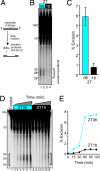Circadian oscillation of nucleotide excision repair in mammalian brain
- PMID: 19164551
- PMCID: PMC2629438
- DOI: 10.1073/pnas.0812638106
Circadian oscillation of nucleotide excision repair in mammalian brain
Abstract
The circadian clock regulates the daily rhythms in the physiology and behavior of many organisms, including mice and humans. These cyclical changes at molecular and macroscopic levels affect the organism's response to environmental stimuli such as light and food intake and the toxicity and efficacy of chemo- and radiotherapeutic agents. In this work, we investigated the circadian behavior of the nucleotide excision repair capacity in the mouse cerebrum to gain some insight into the optimal circadian time for favorable therapeutic response with minimal side effects in cancer treatment with chemotherapeutic drugs that produce bulky adducts in DNA. We find that nucleotide excision repair activity in the mouse cortex is highest in the afternoon/evening hours and is at its lowest in the night/early morning hours. The circadian oscillation of the repair capacity is caused at least in part by the circadian oscillation of the xeroderma pigmentosum A DNA damage recognition protein.
Conflict of interest statement
The authors declare no conflict of interest.
Figures




Comment in
-
It's all in a day's work: Regulation of DNA excision repair by the circadian clock.Proc Natl Acad Sci U S A. 2009 Feb 24;106(8):2481-2. doi: 10.1073/pnas.0813323106. Proc Natl Acad Sci U S A. 2009. PMID: 19240220 Free PMC article. No abstract available.
References
-
- Reppert SM, Weaver DR. Coordination of circadian timing in mammals. Nature. 2002;418:935–941. - PubMed
-
- Panda S, Hogenesch JB, Kay SA. Circadian rhythms from flies to human. Nature. 2002;417:329–335. - PubMed
-
- Stevens RG. Circadian disruption and breast cancer: From melatonin to clock genes. Epidemiology. 2005;16:254–258. - PubMed
-
- Levi F, Schibler U. Circadian rhythms: Mechanisms and therapeutic implications. Annu Rev Pharmacol Toxicol. 2007;47:593–628. - PubMed
-
- Kobayashi M, Wood PA, Hrushesky WJ. Circadian chemotherapy for gynecological and genitourinary cancers. Chronobiol Int. 2002;19:237–251. - PubMed
Publication types
MeSH terms
Substances
Grants and funding
LinkOut - more resources
Full Text Sources
Other Literature Sources
Molecular Biology Databases

